
No. 206 Squadron is a Test and Evaluation Squadron of the Royal Air Force. Until 2005 it was employed in the maritime patrol role with the Nimrod MR.2 at RAF Kinloss, Moray. It was announced in December 2004 that 206 Squadron would disband on 1 April 2005, with half of its crews being redistributed to Nos. 120 and 201 Squadrons, also stationed at Kinloss. This was a part of the UK Defence Review called Delivering Security in a Changing World; the Nimrod MR.2 fleet was reduced in number from 21 to 16 as a consequence.

Number 23 Squadron is a squadron of the Royal Air Force responsible for 'day-to-day space operations', having been reformed in January 2021, as the first "space squadron". Up until its disbandment in October 2009, it operated the Boeing Sentry AEW1 Airborne Warning And Control System (AWACS) aircraft from RAF Waddington, Lincolnshire.
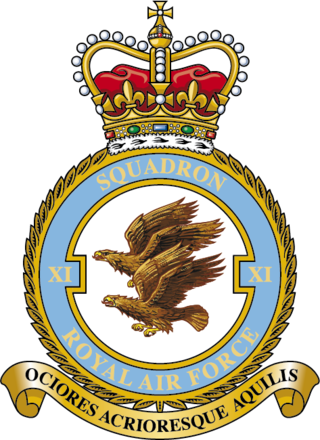
No. 11 or XI Squadron, is "the world's oldest, dedicated fighter unit" and continues the traditions established by the similarly numbered Royal Flying Corps squadron, established in 1915. After a history of equipment with numerous different aircraft types, the squadron most recently operated the Tornado F3 until 2005 when it was disbanded. It was reactivated in 2006 to operate the Typhoon F2, receiving its first aircraft on 9 October 2006.
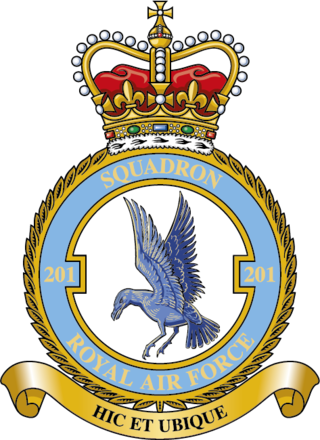
Number 201 Squadron is a squadron of the Royal Air Force. It currently operates the Boeing Poseidon MRA1 from RAF Lossiemouth, Moray.
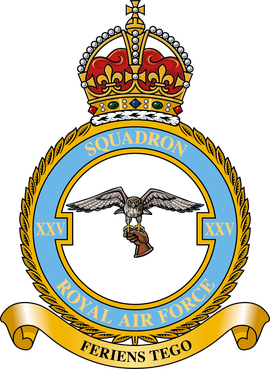
Number 25 (Fighter) Squadron is a squadron of the Royal Air Force having reformed on 8 September 2018.
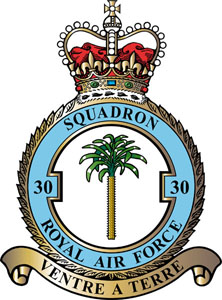
No. 30 Squadron of the Royal Air Force operates the Airbus A400M Atlas transport aircraft and is based at RAF Brize Norton, Oxfordshire.

No. 47 Squadron is an inactive squadron of the Royal Air Force. Formed in 1916, it saw service during the First World War in the UK and in Greece. Between the wars it served in Egypt and Sudan, and at the outbreak of the Second World war undertook bombing operations against Italian positions in Eritrea. Later it was based in Libya and Tunisia, taking part in anti-shipping operations in the Mediterranean. In 1944 the squadron moved to India, and began operations against the Japanese in Burma and elsewhere.

No. 84 Squadron of the Royal Air Force is at present a Search and Rescue Squadron based at RAF Akrotiri, using the Westland/Airbus Helicopters Puma HC Mk.2 helicopter. The squadron transitioned from the previously operated Bell Griffin HAR.2 to the Puma HC.2 in 2023.

No. 461 Squadron was a Royal Australian Air Force maritime patrol squadron during World War II which operated under Royal Air Force control flying in Europe and over the Atlantic. The squadron was formed in 1942 and was disbanded in mid-1945, just after the end of the war in Europe. Personnel were drawn from many countries of the British Empire, although the majority were Australians. Throughout the war, the squadron was credited with destroying a total of six German U-boats, and operated mainly in the Bay of Biscay and Atlantic.
No. 36 Squadron of the Royal Flying Corps was formed in 1916 at Cramlington Aerodrome, just north of Newcastle-upon-Tyne, in order to defend a section of the North East coast from German Zeppelin attacks at night. Disbanded shortly after the end of WWI, it was reformed as a torpedo bomber unit and served in Singapore and Burma in the 1930s, seeing action in 1941–42 when Japan entered the war. After re-equipping with Vickers Wellingtons, it served the remainder of the war as an anti-submarine unit, in the Indian Ocean, the Mediterranean, and later in UK home waters. After WWII the squadron operated intermittently in various roles, including maritime reconnaissance, and later as a transport unit flying C-130 Hercules until it was disbanded for the last time in 1975.

No. 40 Squadron of the Royal Air Force was formed in 1916 at Gosport as No. 40 Squadron Royal Flying Corps and was disbanded for the last time in 1957. The squadron also included many non-British members, including volunteers from the Royal Australian Air Force and Royal Canadian Air Force.
No. 203 Squadron RAF was originally formed as No. 3 Squadron Royal Naval Air Service. It was renumbered No. 203 when the Royal Air Force was formed on 1 April 1918.

No. 65 Squadron was a squadron of the Royal Air Force.

No. 205 Squadron was a Royal Air Force unit formed on 1 April 1918. Prior to this it had existed as No. 5 Squadron of the Royal Naval Air Service (RNAS). In 1929, it became the first RAF squadron to be permanently based in Singapore, taking as its motto Pertama di Malaya. No. 205 Squadron operated during the Second World War and the Cold War before disbanding on 31 October 1971.
No. 62 Squadron of the Royal Air Force was originally established as a Royal Flying Corps squadron in 1916 and operated the Bristol F2B fighter in France during the last year of the First World War. After the war the squadron was disbanded and it was re-established in 1937 as part of the buildup of the RAF in the late 1930s. During the Second World War the Squadron was deployed to the Far East, operating the Bristol Blenheim from Singapore and Malaya. In 1942 No. 62 Squadron was re-equipped with the Lockheed Hudson and it moved to Sumatra, then Burma and then India. After the close of World War II the squadron disbanded for the second time. It was briefly re-established from 1946 to 1947 as a Dakota squadron and operated out of Burma and India. It final incarnation was as a Bristol Bloodhound missile unit in the early 1960s.

Number 57 Squadron, also known as No. LVII Squadron, is a Royal Air Force flying training squadron, operating the Grob Prefect T1 from RAF Cranwell, Lincolnshire.

Number 209 Squadron of the British Royal Air Force was originally formed from a nucleus of "Naval Eight" on 1 February 1917 at Saint-Pol-sur-Mer, France, as No. 9 Squadron Royal Naval Air Service (RNAS) and saw active service in both World Wars, the Korean War and in Malaya. The use of the squadron number ceased in 1968 and it has not been reused since by an RAF squadron. However the number, badge and motto is in current service within the RAF Air Cadets at 209 Squadron ATC in Nottinghamshire.
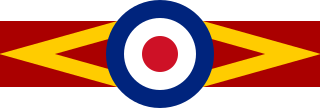
Number 80 Squadron is a squadron of the Royal Air Force. It was reformed on 15 April 2024 at Eglin Air Force Base, Florida, after the numberplate was awarded to the British team at the Australia, Canada and United Kingdom Reprogramming Laboratory (ACURL). It was a Royal Flying Corps (RFC) and Royal Air Force (RAF) squadron active from 1917 until 1969. It was operative during both the First and Second World Wars.

No. 15 Group was a group of the Royal Air Force, which disbanded in 1945. It was operational in the last year of, and just after, the First World War, a reformation saw it active throughout the Second World War.



















